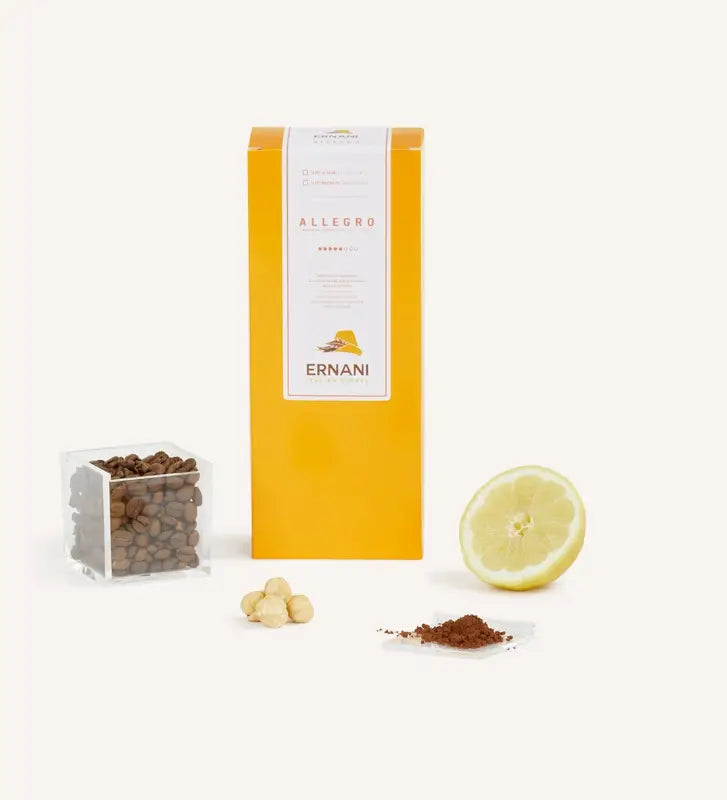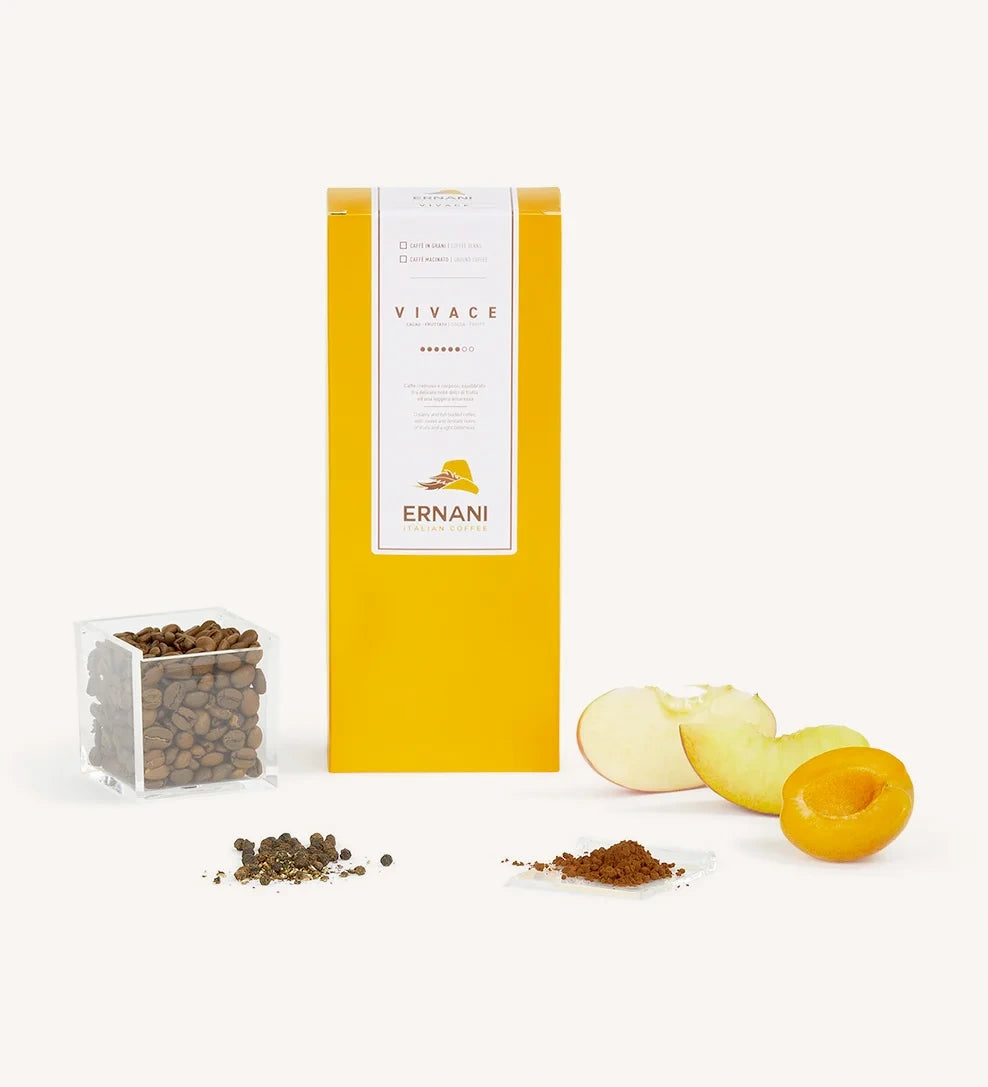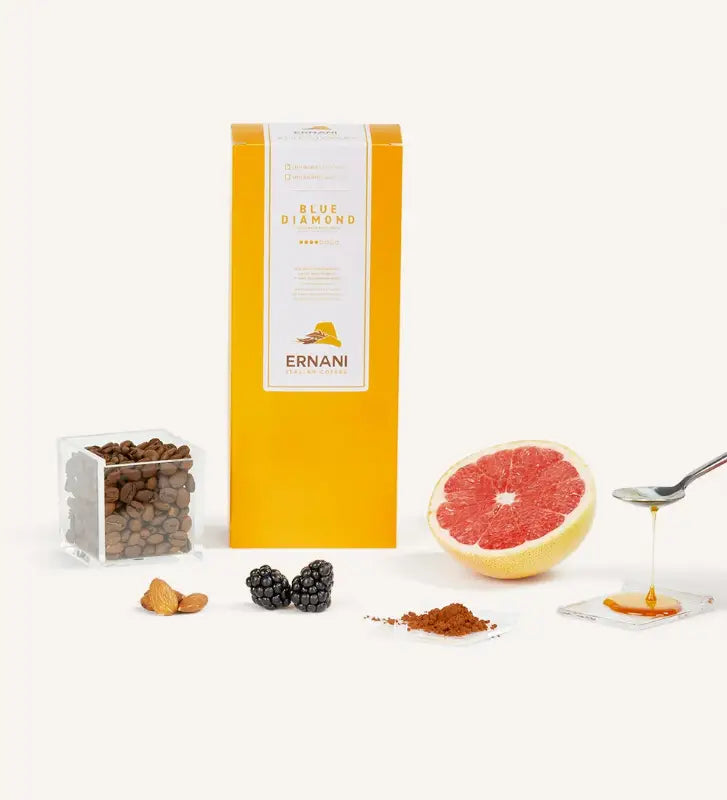
Blue Diamond - 250g / 1kg
Save up to 10% by choosing periodic delivery
Description
A premium blend that encompasses the characteristics and aromas of four single-origin Arabica beans, with hints of fruit and nuts, citrus, honey, and chocolate.
100% arabica:
- Colombia Finca la Meseta, washed
- Brasile Bom chocolate, natural
- India Kalledevarapura, semi-washed
- Etiopia Sidamo, washed
- On the nose: the aroma is intense and has notes of cocoa and fruit
- Taste: A pronounced acidity is immediately noticeable, with notes of pink grapefruit, which fades in favor of sweetness, with hints of blackberry and plum. Finally, delicate notes of toast, white chocolate, almond, and honey emerge.
Ernani's advice: for espresso, use a dose of 8.5 g per dose.
Suitable for
For those seeking a fine, delicate, and fresh blend that encompasses the qualities and aromas of 4 different single-origin coffees.
Technical data sheet
- Aromatic notes: blackberry, pink grapefruit, honey, white chocolate and almond
- Intensity: 6.5/9
- Body: 4/9
- Sweetness: 4.5/9
- Bitterness: 2/9
- Acidity: 7/9
- Aromatic intensity: 6.5/9
- Roasting: medium
- Composition: 100% Arabica
- Origins: Ethiopia Sidamo washed arabica, Colombia Finca la Meseta washed arabica, India Kalledevarapura washed arabica, Brazil Bom Chocolate natural arabica
Thanks to the medium roast, the carefully selected raw coffee beans can express themselves to their fullest, releasing all their natural aromas without ever being overly bitter. Try it without sugar, it's incredible!
The coffee is stored inside a sealed bag, self-protected with a one-way valve, which allows the coffee to degas, preventing oxygen from entering, which would otherwise oxidize it. This keeps the coffee fresh and aromatic even after several months.
Notes for the 1kg grain pack:
- Roasted coffee beans
- 1000 g net weight
- Packaged with one-way valve
Notes for the 250g grain pack:
- Roasted coffee beans
- Packaged in a protective atmosphere of food-grade nitrogen with a one-way valve
- 250 g net weight
Notes for the 250g ground pack:
- Coffee beans roasted and then ground
- Packaged in a protective atmosphere of food-grade nitrogen with a one-way valve
- 250 g net weight
History of coffee
Today we travel to four different countries with our award-winning Blue Diamond blend: Ethiopia, Colombia, India, and Brazil.
You've already tasted the four single-origin coffees, now try them as a blend and discover how they enhance each other, creating a unique and complex flavor.
Ethiopia
Let's start with Ethiopia, the country where the coffee plant originated and hence the traditions around it around the world.
Coffee has always had a sacred meaning in Ethiopia, becoming an integral and indispensable part of the country's economy, politics, rituals, language... in short, of its entire way of life.
The coffee ceremony follows a precise ritual, placing great importance on conversation and human connection. It is performed three times a day by the housewife, dressed in a white dress with colored trim, serving three rounds of coffee to each participant, and each round has its own meaning.
The beans are still roasted by hand in a pan placed directly over an open flame, constantly stirred by the same woman. They are then ground and left to infuse in a traditional coffee maker.
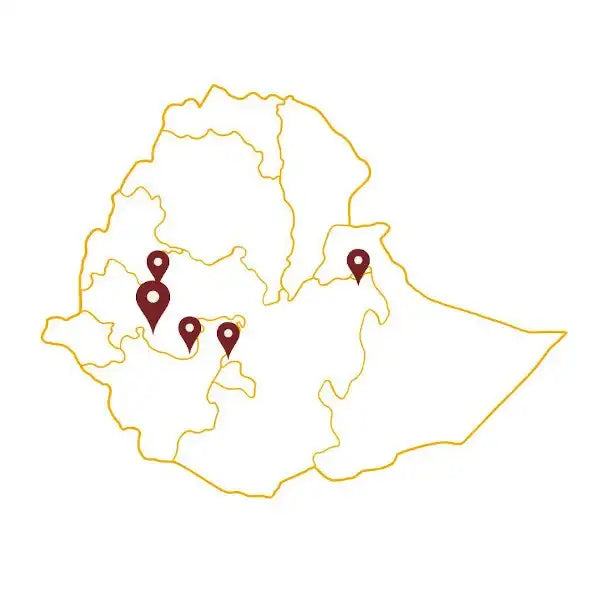
Coffee in Ethiopia is truly considered a small, great miracle of nature, as there are no large plantations in the area, as in other countries, but rather the fruit of the labor of many small producers and local families who often grow the plants directly in their own "backyards." These small farmers number approximately 12 million.
Since everything is very domestic, the growers do not use chemicals or substances toxic to the environment, leaving the soil pure and free to breathe, positioning the coffee plants in the shade of other crops and tall trees.
All this makes Ethiopian coffee one of the most prized in the world, with aromatic, intense and flawless beans.
On the palate, it presents fresh and delicate aromas of citrus, red fruits, and flowers, enhanced by spicier notes or hints of chocolate and dried fruit. The sweet notes often evoke honey and caramel.
Colombia
Now we fly to Colombia, among the most evocative coffee-growing regions in the world, so much so that its landscapes are a UNESCO World Heritage Site.

The Eje Cafetero is a rural area that extends across several departments toward the south of the state, beyond Medellin. The best known are Caldas, Quindio, Risaralda, Tolima, and Valle del Cauca.
Here, life flows slowly, in contact with and respect for nature, made of simplicity and centuries-old cultural traditions.
Coffee has influenced the economy, lifestyle, traditions, habits and customs of the small historic villages of coffee growers, who pass down knowledge and skills from father to son.
When I drink a cup of Colombia Supremo Finca la Meseta, I close my eyes and imagine myself among the beautiful thermal areas, immersed in vast plantations of an intense emerald green, embraced by cloud forests, between steep valleys and glaciated peaks, kissed by the sun and overlooking the National Parks of the Andes.
Here is the hacienda from which we buy our Colombian coffee, from the Finca called La Meseta.
A region dotted with Andean forest, with a climate ranging from 8° to 24° Celsius, altitudes between 1,100 and 2,000 meters, and constant rainfall year-round. All this makes the land perfect for growing a top-quality coffee.
And to honor their product, the recognedores, or pickers of the red berries, always work by hand, making a careful selection and picking only the perfectly ripe cherries.
The flavor is smooth, fresh, fruity, floral, and almondy. Sniff a cup of Blue Diamond and you'll sense this intense almond note!
Find out more about this coffee by clicking here
India
We now move on to India, among the Baba Budan Giri hills, below the Tropic of Cancer, which constitute the main region for the production and consumption of the dark drink.
In particular, with our Kalledevarapura, we are located in the region of Karnataka and Tamil Nadu.
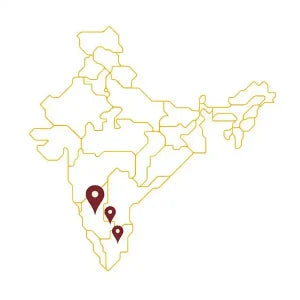
These regions are cool year-round and enjoy abundant rainfall. The soil is deep and fertile. Furthermore, this area is characterized by the presence of tall trees, which allow coffee plants to be grown in the shade, protecting them from the strong, hot direct sun.
These conditions create fertile ground for growing great coffee!
The same plantations grow not only coffee, but also pepper, cardamom, cinnamon, cloves, nutmeg, and 45 other plant species. This botanical diversity gives the beans a wide aromatic variety and intense flavor.
In short, I imagine a trip to the Indian plantations with my eyes closed and my nose in the air, ready to capture all the imaginative automatic nuances and the intoxicating scent of flowers, fruits and spices.
Overall, Indian Arabica coffees have good acidity and creaminess, rich in aromas: from tea leaves to chocolate, from ripe fruit pulp to red berries, from chocolate to honey, and from nuts to spices and tobacco. In short, a triumph of flavor.
Find out more about this coffee by clicking here.
Brazil
We end our world journey by returning to Brazil, the world's leading country in terms of coffee production and sales, and therefore one of the most widely consumed and well-known coffees!
Brazil boasts a multitude of coffee farms, both sprawling, industrially farmed coffee farms that produce low-quality coffee, and micro-farms specializing in specialty coffee. In short, the coffee-growing region is vast and diverse.
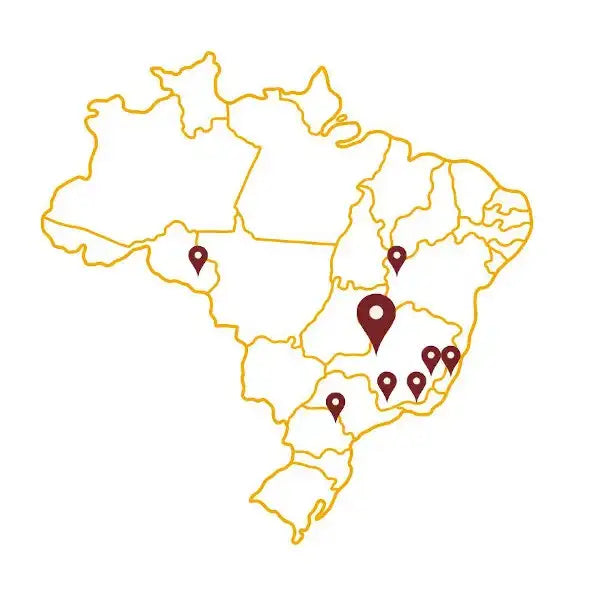
The two departments known for producing quality coffee are the Cerrado region, where our Bom Chocolate comes from, and the Minas Gerais region to the southeast of the former.
The Cerrado region obtained the IP (Indication of Provenance) label in 2005 and the DO (Protected Designation of Origin) label in 2014. As mentioned, this region is characterized by the quality of its raw beans and its unique climatic conditions. Furthermore, the coffee plants have intense flowering, with uniform ripening of a concentrated crop, combined with perfectly defined climatic seasons, with hot, humid summers and mild, dry winters.
A set of perfectly synchronized variables that create unique and ideal conditions for our beloved plant with bright red fruits.
Authentic Cerrado Mineiro coffee has intense aromas, a caramel flavor and hints of dried fruit, with a delicate citrus acidity and a predominantly chocolatey flavor that is very persistent.
I imagine Brazil as vast, made up of hills and plateaus between 900 and 1600 meters above sea level. Greenery and fields as far as the eye can see, with a clear sky contrasting with the land.
Find out more about this coffee by clicking here
So, with a taste of our Blue Diamond you will first find yourself in Central Africa, in Ethiopia, with fresh and almost pungent hints of citrus and flowers.
Immediately after comes the delicacy of Colombian fruit, accompanied by the aromatic intensity of Indian spices, to finally find ourselves in Brazil, with notes of toasted, caramel and chocolate, among the cocoa plants.
This blend is excellent in filter coffee, with a moka pot, in espresso and even cold brew!
Find out how to best prepare it with all the tools here.
Have a good trip!
You might be interested in







